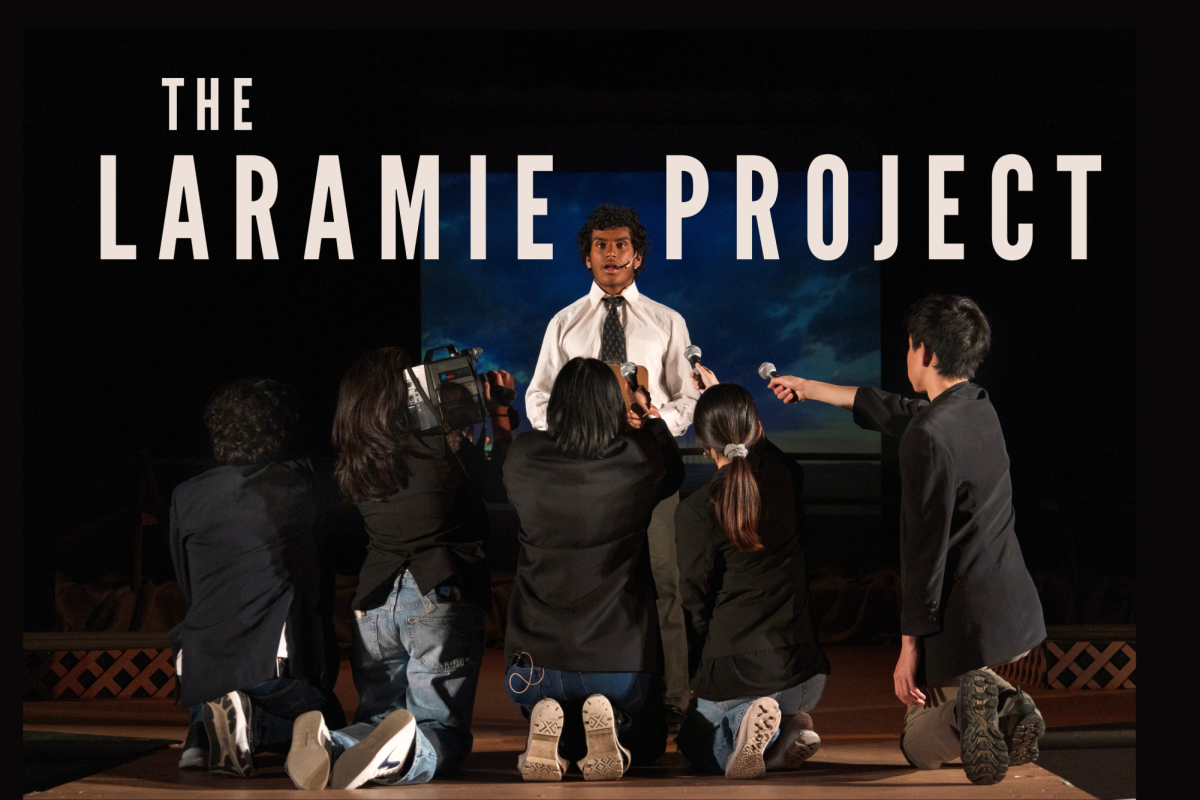Captivating the audience with a passionate performance, Studio 74 actors presented “the Laramie Project” from April 4-6. Performers brought the project to life, leaving the audience with powerful messages about prejudice, homophobia and tolerance.
“The Laramie Project” is a docudrama based off of the murder of Matthew Shepard in Laramie, Wyoming. Shepherd, a young gay man who attended the University of Wyoming was murdered in a hate crime that targeted his sexual identity. After the incident, at the behest of The Tectonic Theater Project, a series of interviews were conducted with residents of Laramie in the wake of Shepherd’s murder, and those responses formed the basis of what would become the Laramie Project.
Starting in mid-January, Studio 74 performers dedicated four days a week, two hours per day, to learning about their roles, memorizing and rehearsing to perfect their lines. As the final performance date neared, dress rehearsals began, requiring the crew and performers to have daily 4-hour practices sessions. While actors practiced their stage lines and gestures, other crew members prepared behind the scenes. Taking up an equally important role in the play, they helped actors with costumes and makeup, directed the lighting and controlled other background effects.
On the three consecutive evenings showcasing “the Laramie Project,” Studio 74 performers skillfully executed their lines and acting, putting on captivating performances each night. The cast members’ commitment to accurately portraying their characters greatly contributed to the production’s success, but this did not come without hardships.
During preparation, actors worked to overcome differences between their own personality and their roles before fully embracing their characters. With 20 performers and over 60 characters, many actors were required to take on multiple roles. Consequently, performers spent ample time researching their various roles in order to understand different backgrounds and enact a realistic representation of their characters.
“We really wanted to do justice to what actually happened in Laramie,” sophomore and performer Ishana Subrahmanyan said.
Beyond creating a historically accurate set with props and costumes, actors also hoped to recreate the unique dialogue styles in the play. Set in the late-1990s in Wyoming, performers spent numerous practices perfecting Midwestern accents. Additionally, the demographics and community values in the play’s setting differed from modern-day customs. Actors were thus required to fully immerse themselves in Midwestern culture and customs exhibited by Laramie’s residents, so as to fully embody their characters.
Nailing down the dialogue and accents, Studio 74 actors came one step closer to turning their goals into fruition. With the combined effort of crew members’ attention to detail in the makeup, costumes, lighting, the production came to life. On each subsequent showing of “the Laramie Project”, performers made subtle tweaks, improving the overall experience of the show. Many of the performers and production director Larry Wenner agreed that their last performance on Saturday was the most memorable out of the three nights. Senior Alexis Giaquinta recalls that the Saturday night audience was particularly engaged, interacting with the performers through appropriate laughter and applause.
Reflecting on the production and entire experience, performers reveal that although practices were challenging at times, they were equally rewarding and entertaining. During dress rehearsals, the women’s dressing room turned into a choir room as performers sung Broadway songs while preparing to perform. As the lines, staging and acting gradually came together, the performers and Wenner were all proud of their accomplishments.
“When actors pass the point of saying lines that they’ve memorized and begin to actually live those lines, we start to create something that’s real onstage,” Wenner said.
Studio 74’s performance captured the hearts of its viewers, many of whom were entranced by the touching and reflective enactment of the true crime. The sensitive, raw elements of this play, along with its messages about homophobia and hatred, brought many in the audience to tears.
“While we live in a sheltered area, it is important to realize that homophobia is still present,” Giaquinta said. “Even the small acts of hatred are a form of violence against the LGBTQ+ community.”
If audiences are to take anything away from this play, performers and Wenner hope that they can learn to recognize the devastating consequences and impacts of homophobia and hate crimes on individuals and communities.
“The play covered an important topic in an entertaining while thoughtful way,” senior and spectator Anshul Singh said. “I commend the actors’ commitment to their roles and hope they attempt similarly bold scripts in the future.”









































































